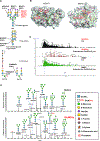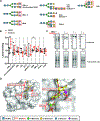A photo-cross-linking GlcNAc analog enables covalent capture of N-linked glycoprotein-binding partners on the cell surface
- PMID: 34331854
- PMCID: PMC8792112
- DOI: 10.1016/j.chembiol.2021.07.007
A photo-cross-linking GlcNAc analog enables covalent capture of N-linked glycoprotein-binding partners on the cell surface
Abstract
N-glycans are displayed on cell-surface proteins and can engage in direct binding interactions with membrane-bound and secreted glycan-binding proteins (GBPs). Biochemical identification and characterization of glycan-mediated interactions is often made difficult by low binding affinities. Here we describe the metabolic introduction of a diazirine photo-cross-linker onto N-acetylglucosamine (GlcNAc) residues of N-linked glycoproteins on cell surfaces. We characterize sites at which diazirine-modified GlcNAc is incorporated, as well as modest perturbations to glycan structure. We show that diazirine-modified GlcNAc can be used to covalently cross-link two extracellular GBPs, galectin-1 and cholera toxin subunit B, to cell-surface N-linked glycoproteins. The extent of cross-linking correlates with display of the preferred glycan ligands for the GBPs. In addition, covalently cross-linked complexes could be isolated, and protein components of cross-linked N-linked glycoproteins were identified by proteomics analysis. This method may be useful in the discovery and characterization of binding interactions that depend on N-glycans.
Keywords: N-glycan; cholera; cross-linking; diazirine; galectin; glycosylation; glycosyltransferase.
Copyright © 2021 Elsevier Ltd. All rights reserved.
Conflict of interest statement
Declaration of interests K.W.M. acknowledges ownership interest and roles as president and CEO of Glyco Expression Technologies, Inc., a biotechnology spinout commercializing recombinant glycosyltransferases, and may conceivably profit from the results described herein. J.J.K. is a member of the advisory board for Cell Chemical Biology. Other authors declare no competing interests.
Figures







Similar articles
-
Metabolism of diazirine-modified N-acetylmannosamine analogues to photo-cross-linking sialosides.Bioconjug Chem. 2011 Sep 21;22(9):1811-23. doi: 10.1021/bc2002117. Epub 2011 Aug 25. Bioconjug Chem. 2011. PMID: 21838313 Free PMC article.
-
Enhanced transfer of a photocross-linking N-acetylglucosamine (GlcNAc) analog by an O-GlcNAc transferase mutant with converted substrate specificity.J Biol Chem. 2015 Sep 11;290(37):22638-48. doi: 10.1074/jbc.M115.667006. Epub 2015 Aug 3. J Biol Chem. 2015. PMID: 26240142 Free PMC article.
-
Recent advances in photoaffinity labeling strategies to capture Glycan-Protein interactions.Curr Opin Chem Biol. 2024 Jun;80:102456. doi: 10.1016/j.cbpa.2024.102456. Epub 2024 May 4. Curr Opin Chem Biol. 2024. PMID: 38705088 Review.
-
Metabolic labeling enables selective photocrosslinking of O-GlcNAc-modified proteins to their binding partners.Proc Natl Acad Sci U S A. 2012 Mar 27;109(13):4834-9. doi: 10.1073/pnas.1114356109. Epub 2012 Mar 12. Proc Natl Acad Sci U S A. 2012. PMID: 22411826 Free PMC article.
-
The bisecting GlcNAc in cell growth control and tumor progression.Glycoconj J. 2012 Dec;29(8-9):609-18. doi: 10.1007/s10719-012-9373-6. Epub 2012 Apr 4. Glycoconj J. 2012. PMID: 22476631 Free PMC article. Review.
Cited by
-
Selective bioorthogonal probe for N-glycan hybrid structures.Nat Chem Biol. 2024 Oct 28. doi: 10.1038/s41589-024-01756-5. Online ahead of print. Nat Chem Biol. 2024. PMID: 39468349
-
A Bioorthogonal Precision Tool for Human N-Acetylglucosaminyltransferase V.J Am Chem Soc. 2024 Oct 2;146(39):26707-26718. doi: 10.1021/jacs.4c05955. Epub 2024 Sep 17. J Am Chem Soc. 2024. PMID: 39287665 Free PMC article.
-
A nondestructive membrane engineering method using an amphiphilic polymer.Protein Sci. 2024 Sep;33(9):e5143. doi: 10.1002/pro.5143. Protein Sci. 2024. PMID: 39150080
-
Asymmetrical Biantennary Glycans Prepared by a Stop-and-Go Strategy Reveal Receptor Binding Evolution of Human Influenza A Viruses.JACS Au. 2024 Jan 23;4(2):607-618. doi: 10.1021/jacsau.3c00695. eCollection 2024 Feb 26. JACS Au. 2024. PMID: 38425896 Free PMC article.
-
(Glycan Binding) Activity-Based Protein Profiling in Cells Enabled by Mass Spectrometry-Based Proteomics.Isr J Chem. 2023 Mar;63(3-4):e202200097. doi: 10.1002/ijch.202200097. Epub 2023 Jan 18. Isr J Chem. 2023. PMID: 37131487 Free PMC article.
References
-
- Camby I, Le Mercier M, Lefranc F, and Kiss R (2006). Galectin-1: a small protein with major functions. Glycobiology 16, 137R–157R. - PubMed
-
- Cummings RD, and Kornfeld S (1984). The distribution of repeating [Gal beta 1,4GlcNAc beta 1,3] sequences in asparagine-linked oligosaccharides of the mouse lymphoma cell lines BW5147 and PHAR 2.1. J Biol Chem 259, 6253–6260. - PubMed
Publication types
MeSH terms
Substances
Grants and funding
LinkOut - more resources
Full Text Sources
Research Materials

